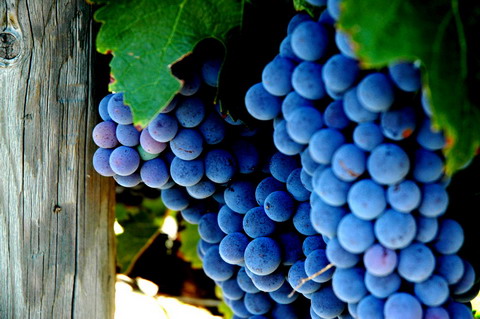 Continued from Part 2 of High Alcohol Wine …
Continued from Part 2 of High Alcohol Wine …
So for every fifty samples I taste, I probably consume the equivalent of a glass of wine—and that adds up.
As the day wears on, my spitting technique becomes less refined, more like dribbling. Between that and my increasing enthusiasm for swirling my samples, the purple-stained napkins are piling up around me.
My voice rises, my carefree laugh floats across the room, until someone inevitably asks, “Enjoying yourself, Natalie?”
Where was I? Oh yes, back in the vineyard, talking about grapes. “Ripeness is all,” as Shakespeare once said and a growing number of winemakers agree.
But how ripe is too ripe?
Since 1920, the sugar content of grapes has been assessed with a tool called a spectrometer, which measures degrees of brix, or baumé, oechsle or KMW depending on the region.
In the 1980s, most Californian vintners picked their grapes when they had achieved 23 degrees brix, which crept up to 24.8 in 2001.
That translated into a rise from 13.1 percent alcohol to 15.1 percent. In Australia, the average alcohol in red wine rose from 12.4 percent in 1984 to 14 percent in 2004.
(Here are my top reviews of wines between 13 and 14% alcohol.)
Getting uptight about a few percentage points may seem neurotic. But think about two wines, one at 12 percent alcohol and the other with 16 percent: would you rather have three glasses of wine or just two?
It comes to the same amount of alcohol. While we may not notice alcohol creeping up over the years, the result is a bit like the experiment in which heat was slowly increased under a frog in the pot of water—eventually we too become  cooked, or at least, our brain does.
cooked, or at least, our brain does.
What’s happening is that winemakers have stopped relying solely on their brix readings to know when to pick their grapes and are instead tasting them for maturity.
As grapes ripen, their seeds turn from green to brown, their skins thicken and develop more flavor and color, and the rasping tannins soften. Fruit flavors mature from a puckery vegetative-green, to ripe fresh fruit, to overly ripe jam and chocolate and finally to cooked and burnt.
Rather than considering sugar content, vintners now assess the overall physical ripeness of the fruit’s flesh, seeds and skins by tasting.
This “phenolic” maturity relates to the development of the natural compounds in grapes that are responsible for the wine’s eventual color, aroma, flavor, bitterness, texture and astringency.
Therefore, vintners have started leaving grapes on their vines longer in the fall, a waiting period called “hang time.” That’s because phenolic ripeness is more a function of time than of heat.
I liken sugar in grapes to the intelligence quotient (IQ) in people and phenolic maturity to emotional quotient (EQ). Even young children can have a high IQ, but only with time can they develop the wisdom that equates to a high EQ.
On top of all these changes, another factor influencing ripeness may be global warming. The earth’s climate has fluctuated for centuries, but some scientists believe that it’s never before shown such rapid temperature increases.
According to the American writer Tim Flannery in his book The Weather Makers, nine of the ten hottest years on record have occurred since 1990.
Aubert de Villaine, winemaker for the famed burgundy Romanée-Conti, notes that harvest dates have moved back by about a week per decade since the 1970s: grapes are now picked in mid-September.
The heat wave that swept Europe in the summer of 2003 had temperatures that were 7.7oF (4.3oC) higher than previous averages.
Later harvesting isn’t the only factor boosting alcohol in some New World vineyards. In 1980s and 1990s, after the phylloxera root louse destroyed many Californian vineyards, they were replanted using European-style trellising and canopy management.
This exposes the grapes to more sunlight, speeding up their metabolic process. Modern vines, custom-grafted in the nursery, also photosynthesize sunshine into sugar far more efficiently than their ancestors.
Some vintners choose certain clones of grapes that highlight the black fruit flavors in their wine, making them taste more robust and, in my opinion, more appallingly uniform.
Another technique that growers use is “green harvesting”: slow-ripening bunches of grapes are pulled off the vines and discarded. This forces the vines to concentrate their nutrients in the remaining grapes. 
Even in regions where irrigation is legal, some producers choose to dry farm their vines, so the grapes dehydrate, further concentrating their flavors.
Done early in the season, this makes the vines conserve their nutrients for the fruit rather than wasting them on leaves. This is actually one of the few natural ways to develop the phenolics in the fruit earlier, and thus, to balance the sugar and phenolic development.
They may also try other natural approaches, such as using root stocks and clones that aren’t too vigorous, trellising the vines to make them work for their nutrients, removing shoots and leaves early in the season to concentrate the nutrients in the remaining grapes and using yeasts that ferment the wine at a lower level of alcohol.
But for many producers, especially those in hot climates, the natural way of reducing alcohol is either difficult or expensive.
Another advance that helps to keep the grapes on the vines longer, especially in damp, cool regions, is better sprays against rot, mildew and fungal diseases. Viruses that once attacked vine leaves have almost been eliminated, so the leaves stay green and keep absorbing sunlight throughout the entire growing season.
Once the grapes are picked and taken to the winery, other factors can increase alcohol. In some regions, vintners add sugar to the fermenting wine to increase its alcohol—a practice called chaptalization. This is legal in some regions, especially in …
Continue to Part 4 of High Alcohol Wine







